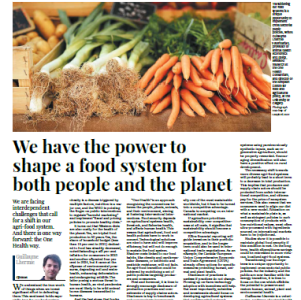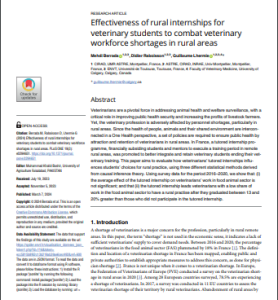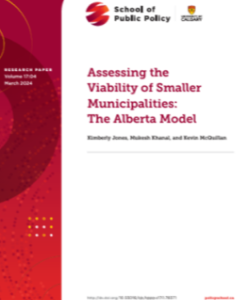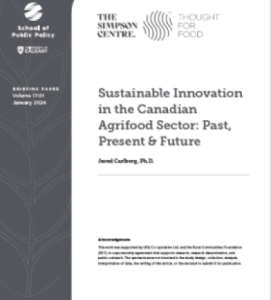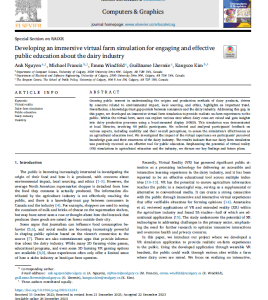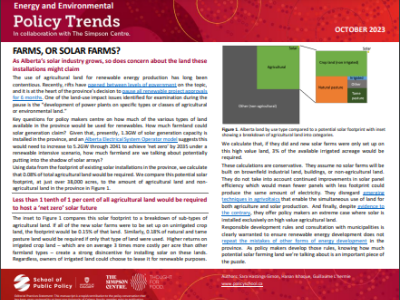Publications
We are facing interdependent challenges that call for a shift in our agri-food system. And there is one way forward: the One Health way. Transitioning our food systems is a unique opportunity to implement cross sectorial public policies. It is time to focus on the potential to preserve and restore human, animal, plant and environmental health.
Source: Hill Times
Monday, March 18, 2024
Guillaume Lhermie
Veterinarians are a pivotal force in addressing animal health and welfare surveillance, with a critical role in improving public health security and increasing the profits of livestock farmers. Yet, the veterinary profession is adversely affected by personnel shortages, particularly in rural areas. Since the health of people, animals and their shared environment are interconnected in a One Health perspective, a set of policies are required to ensure public health by attraction and retention of veterinarians in rural areas. In France, a tutored internship programme, financially subsiding students and mentors to execute a training period in remote rural areas, was promoted to better integrate and retain veterinary students ending their veterinary training. This paper aims to evaluate how veterinarians’ tutored internships influences students’ choices for rural practice, using three different statistical methods derived from causal inference theory. Using survey data for the period 2016–2020, we show that: (i) the average effect of the tutored internship on veterinarians’ work in food animal sector is not significant; and that (ii) the tutored internship leads veterinarians with a low share of work in the food animal sector to have a rural practise after they graduated between 13 and 20% greater than those who did not participate in the tutored internship.
Thursday, March 07, 2024
Mehdi Berrada, Didier Raboisson & Guillaume Lhermie
Small towns, villages and rural areas in Alberta face serious fiscal challenges due to economic and social trends that have seen their populations stagnate or decline while job opportunities and young people leave for bigger cities. While other provinces have opted for sweeping reorganization to local governments, including amalgamation, annexation or the establishment of regional forms of government, Alberta has chosen a case-by-case approach to its municipalities through the use of viability reviews.
Alberta’s viability review process is an excellent way for the province to monitor and address the fiscal struggles of individual municipalities. More must now be done to fine-tune the postdissolution process so that Alberta Municipal Affairs can equitably address the governance problems that follow.
Friday, March 01, 2024
Kimberly Jones, Mukesh Khanal, and Kevin McQuillan
In order to remain globally competitive with sustainable innovations in agri-food, both the public and private sectors in Canada must increase investment in the industry.
Studies reveal that both sectors’ support for agri-food innovation has declined in recent years. To spur innovation and growth public funding should revert to previous levels, ideally reaching 0.10 per cent of GDP. Incentives such as tax relief, matching funds and enhanced protection of intellectual property rights could spur increased levels of private sector investment in innovation.
In the past 50 years, innovation in agriculture has brought tremendous benefits to producers, processors and consumers. Successful innovations include genetically modified crops, large-scale cattle feeding operations and the adoption of no-till farming, which has reduced the traditional practice of summerfallowing fields. Still, with the demand for a secure global food supply and growing concerns about the environmental impacts of large-scale farming, the need for sustainable innovation in the agri-food sector is pressing.
This paper offers three recommendations for policy-makers. First, public funding for agricultural research and development should be increased to prior levels. Next, the private sector needs more favourable conditions to foster investment in the agri-food industry. Last, if intellectual property rights are strengthened, innovating firms will be reassured that they can capture the economic benefits innovation creates.
Wednesday, January 31, 2024
Jared Carlberg
Growing public interest in understanding the origins and production methods of dairy products, driven by concerns related to environmental impact, local sourcing, and ethics, highlights an important trend. Nevertheless, a knowledge-trust gap persists between consumers and the dairy industry. Addressing this gap, in this paper, we developed an immersive virtual farm simulation to provide realistic on-farm experiences to the public. Within the virtual farm, users can explore various sites where dairy cows are raised and gain insights into dairy production processes using a head-mounted display (HMD). This simulation was demonstrated at local libraries, involving 48 public participants. We collected and analyzed participants’ feedback on various aspects, including usability and their overall perceptions, to assess the simulation’s effectiveness as an agricultural education tool. We investigated the impact of the virtual experience on participants’ perceived knowledge gain and their awareness of the dairy industry. The results indicate that our dairy farm simulation was positively received as an effective tool for public education. Emphasizing the potential of virtual reality (VR) simulations in agricultural education and the industry, we discuss our key findings and future plans.
Tuesday, October 31, 2023
Anh Nguyen, Michael Francis, Emma Windfeld, Guillaume Lhermie and Kangsoo Kim
The use of agricultural land for renewable energy production has long been contentious. Recently, rifts have opened between levels of government on the topic, and it is at the heart of the province’s decision to pause all renewable project approvals for 6 months. One of the land-use impact issues identified for examination during the pause is the “development of power plants on specific types or classes of agricultural or environmental land.”
Key questions for policy makers centre on how much of the various types of land available in the province would be used for renewables. How much farmland could solar generation claim? Given that, presently, 1.3GW of solar generation capacity is installed in the province, and an Alberta Electrical System Operator model suggests this would need to increase to 5.2GW through 2041 to achieve ‘net zero’ by 2035 under a renewable intensive scenario, how much farmland are we talking about potentially putting into the shadow of solar arrays?
Tuesday, October 31, 2023
Sara Hastings-Simon, Hanan Ishaque and Guillaume L’hermie
- 1
- 2
- 3
- …
- 9
- Go to Next Page

